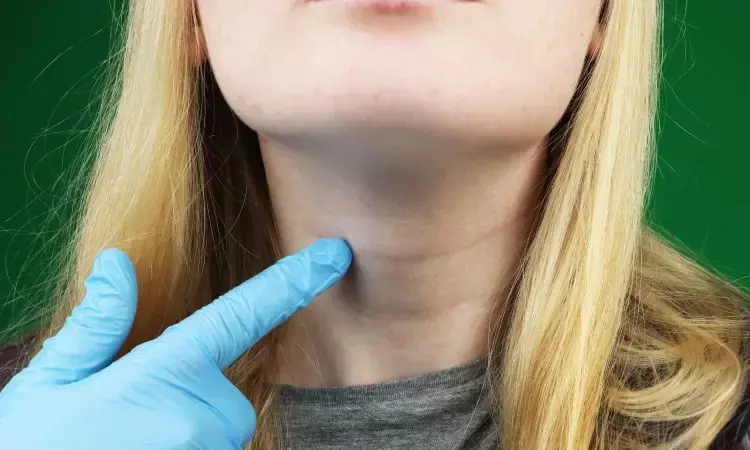- Home
- Medical news & Guidelines
- Anesthesiology
- Cardiology and CTVS
- Critical Care
- Dentistry
- Dermatology
- Diabetes and Endocrinology
- ENT
- Gastroenterology
- Medicine
- Nephrology
- Neurology
- Obstretics-Gynaecology
- Oncology
- Ophthalmology
- Orthopaedics
- Pediatrics-Neonatology
- Psychiatry
- Pulmonology
- Radiology
- Surgery
- Urology
- Laboratory Medicine
- Diet
- Nursing
- Paramedical
- Physiotherapy
- Health news
- Fact Check
- Bone Health Fact Check
- Brain Health Fact Check
- Cancer Related Fact Check
- Child Care Fact Check
- Dental and oral health fact check
- Diabetes and metabolic health fact check
- Diet and Nutrition Fact Check
- Eye and ENT Care Fact Check
- Fitness fact check
- Gut health fact check
- Heart health fact check
- Kidney health fact check
- Medical education fact check
- Men's health fact check
- Respiratory fact check
- Skin and hair care fact check
- Vaccine and Immunization fact check
- Women's health fact check
- AYUSH
- State News
- Andaman and Nicobar Islands
- Andhra Pradesh
- Arunachal Pradesh
- Assam
- Bihar
- Chandigarh
- Chattisgarh
- Dadra and Nagar Haveli
- Daman and Diu
- Delhi
- Goa
- Gujarat
- Haryana
- Himachal Pradesh
- Jammu & Kashmir
- Jharkhand
- Karnataka
- Kerala
- Ladakh
- Lakshadweep
- Madhya Pradesh
- Maharashtra
- Manipur
- Meghalaya
- Mizoram
- Nagaland
- Odisha
- Puducherry
- Punjab
- Rajasthan
- Sikkim
- Tamil Nadu
- Telangana
- Tripura
- Uttar Pradesh
- Uttrakhand
- West Bengal
- Medical Education
- Industry
T2DM patients with subclinical hypothyroidism face elevated macrovascular complications: Study

A new study published in the journal of Cureus showed that the risk of macrovascular problems was 6.75 times greater for diabetic individuals with severe subclinical hypothyroidism (SCH) and 4.35 times higher for the patients with mild SCH.
The prognosis of people with type 2 diabetes is worse when this condition coexists with other thyroid conditions, like subclinical hypothyroidism (SCH). Therefore, it is critical to determine the relationship between macrovascular problems in patients with type 2 diabetes and thyroid function, namely thyroid-stimulating hormone (TSH).
Gaining a comprehensive understanding of TSH and the distinctions and relationships between T2DM patients with SCH and other complications is vital because it will close the knowledge gaps on SCH-T2DM comorbidity and offer vital details about clinical significance, risk factors, and interventions. In addition to examining important metabolic, demographic, and clinical characteristics in T2DM patients with SCH, this study attempts to investigate the relationship between different levels of thyroid-stimulating hormone and the risk of macrovascular problems.
The data from 2017 to 2023 was gathered for a retrospective analysis at Dalian Medical University's Second Affiliated Hospital. Based on their TSH values, 305 patients were split into 3 groups where T2DM moderate SCH (TSH 7.0-9.9 mIU/L), T2DM severe SCH (TSH levels of 10.0 mIU/L or more), and T2DM mild SCH (TSH 4.34-6.9 mIU/L).
For continuous data, one-way analysis of variance (ANOVA) was employed, whilst the chi-square test was utilized for categorical variables. Binary logistic regression analysis, both univariate and multivariate, was used to assess the risk of macrovascular problems. Furthermore, p <0.05 was chosen as the threshold for statistical significance.
Macroscopic problems were most common in patients with severe SCH (19, 90.5%), moderate SCH 38 (80.9%), and mild SCH 142 (59.9%) (p < 0.001). According to multivariate analysis, the risk of macrovascular complications was 4.35 times higher in moderate SCH and 6.08 times higher in severe SCH than in mild SCH.
Macrovascular problems were significantly predicted by male sex, severe SCH, and age group 65 and older. Severe SCH was especially linked to coronary artery disease (CAD) and peripheral arterial disease (PAD). Overall, patients with type 2 diabetes who have severe or moderate SCH are far more likely to get macrovascular problems, including CAD and PAD.
Source:
Mahmud, N. M. M., Jagdewsing, D. R., Ji, X., Harine, I., Adjibou, B., Fahmy, N. S. C., Juby, T., Shuvo, R. I., Alam, A., & Sarmin, S. (2025). Association between different thyroid-stimulating hormone levels and macrovascular complications in subclinical hypothyroidism patients with type 2 diabetes mellitus. Cureus. https://doi.org/10.7759/cureus.79186
Neuroscience Masters graduate
Jacinthlyn Sylvia, a Neuroscience Master's graduate from Chennai has worked extensively in deciphering the neurobiology of cognition and motor control in aging. She also has spread-out exposure to Neurosurgery from her Bachelor’s. She is currently involved in active Neuro-Oncology research. She is an upcoming neuroscientist with a fiery passion for writing. Her news cover at Medical Dialogues feature recent discoveries and updates from the healthcare and biomedical research fields. She can be reached at editorial@medicaldialogues.in
Dr Kamal Kant Kohli-MBBS, DTCD- a chest specialist with more than 30 years of practice and a flair for writing clinical articles, Dr Kamal Kant Kohli joined Medical Dialogues as a Chief Editor of Medical News. Besides writing articles, as an editor, he proofreads and verifies all the medical content published on Medical Dialogues including those coming from journals, studies,medical conferences,guidelines etc. Email: drkohli@medicaldialogues.in. Contact no. 011-43720751


